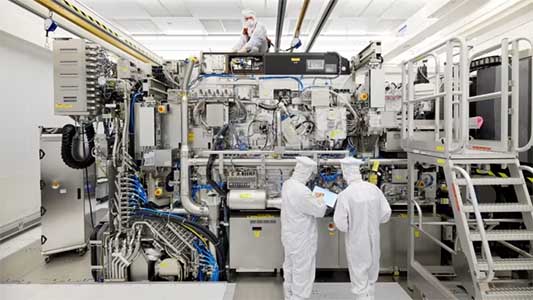Introduction
The semiconductor industry forms the backbone of modern technology, powering everything from smartphones and laptops to electric vehicles, data centers, and emerging artificial intelligence (AI) systems. As demand for faster, more efficient, and energy-conscious electronics grows, the role of semiconductor production equipment has become increasingly vital. These machines enable the precise fabrication of integrated circuits (ICs) and chips that form the building blocks of digital innovation.
Semiconductor equipment manufacturers provide advanced tools for wafer fabrication, lithography, deposition, etching, cleaning, and testing processes, ensuring each microchip meets performance and quality standards. The market is poised for substantial growth, fueled by rapid technological advancements, rising consumer demand for electronics, and large-scale government initiatives to secure semiconductor supply chains.
The global semiconductor production equipment industry was valued at US$ 108.6 Bn in 2022. It is estimated to grow at a CAGR of 4.5% from 2023 to 2031 and reach US$ 152.5 Bn by the end of 2031.
This steady growth reflects the increasing capital expenditure (CAPEX) from major semiconductor foundries and integrated device manufacturers (IDMs). Countries such as the U.S., Taiwan, South Korea, Japan, and China are leading investments in cutting-edge fabrication facilities (fabs) to address the growing semiconductor demand.
Key Growth Drivers
1. Expanding Demand for Consumer Electronics
The widespread adoption of 5G smartphones, wearables, smart appliances, and gaming consoles continues to boost semiconductor demand. Each new generation of devices requires advanced chips manufactured with highly precise equipment, fueling equipment market expansion.
2. Rise of AI, IoT, and Cloud Computing
AI workloads, data analytics, and Internet of Things (IoT) devices demand chips with higher processing power and energy efficiency. Data centers, in particular, are driving demand for semiconductors with specialized architectures. As a result, equipment vendors supplying etching, deposition, and lithography tools are witnessing increased orders.
3. Automotive Semiconductor Surge
Electric vehicles (EVs), autonomous driving systems, and smart mobility solutions depend on semiconductors for battery management, sensors, and connectivity. Automotive-grade chips require specialized production tools that ensure durability and reliability, further expanding equipment demand.
4. Geopolitical and Supply Chain Shifts
The semiconductor industry has faced disruptions due to global trade tensions, the pandemic, and material shortages. Governments worldwide are prioritizing domestic chip manufacturing through initiatives such as the CHIPS and Science Act in the U.S. and Europe’s semiconductor investment plans. These initiatives translate directly into higher demand for advanced production equipment.
Market Segmentation
By Equipment Type
- Wafer Fabrication Equipment: Includes lithography, etching, cleaning, deposition, and metrology tools. This segment dominates the market due to its critical role in chip manufacturing.
- Assembly & Packaging Equipment: Essential for finalizing chips into usable products, with growing demand driven by 3D packaging technologies.
- Testing Equipment: Ensures chips meet reliability and performance standards, increasingly important as devices become more complex.
By Technology Node
- Sub-10nm: The most advanced segment, with growing demand for extreme ultraviolet (EUV) lithography systems.
- 10-20nm: Widely used for high-performance applications such as graphics processors and AI accelerators.
- Above 20nm: Still relevant for legacy applications in automotive and industrial electronics.
By End-use Industry
- Consumer Electronics
- Automotive
- Industrial Automation
- Telecommunications
- Healthcare & Medical Devices
Regional Insights
Asia-Pacific: The Global Leader
Asia-Pacific dominates the semiconductor production equipment market, led by Taiwan, South Korea, Japan, and China. Taiwan Semiconductor Manufacturing Company (TSMC), Samsung Electronics, and SMIC are expanding capacity, driving regional growth.
North America: Strategic Investments
The U.S. is focusing on reducing dependency on Asian suppliers by investing billions into domestic fabs. Intel, GlobalFoundries, and other firms are increasing their equipment purchases.
Europe: Growing Semiconductor Ambitions
The European Union is also investing heavily in semiconductor manufacturing to strengthen supply chain resilience, with companies like ASML playing a pivotal role in lithography systems.
Rest of the World
Regions such as the Middle East are beginning to explore semiconductor investments, particularly for strategic independence and diversification.
Technological Trends
1. Extreme Ultraviolet (EUV) Lithography
EUV technology has become a cornerstone for advanced chip production, allowing manufacturers to shrink transistor sizes while enhancing performance. ASML, a key player, has seen surging demand for its EUV machines.
2. Advanced Packaging
With Moore’s Law slowing, manufacturers are focusing on 3D packaging and heterogeneous integration to enhance chip performance. Equipment that supports wafer-level packaging and chip stacking is gaining traction.
3. Automation and Smart Manufacturing
Industry 4.0 technologies, including robotics, AI, and machine learning, are being integrated into fabs to optimize efficiency and reduce defects. This has created opportunities for smart equipment vendors.
4. Sustainability in Chip Manufacturing
As fabs consume significant energy and water, equipment manufacturers are innovating to reduce environmental footprints. Sustainable production equipment is becoming a competitive differentiator.
Competitive Landscape
The market is consolidated, with a few players dominating wafer fabrication and lithography segments. Leading companies include:
- ASML Holding NV – EUV lithography pioneer.
- Applied Materials Inc. – Specializes in deposition and etching tools.
- Tokyo Electron Limited (TEL) – Offers a wide range of fabrication equipment.
- KLA Corporation – Known for inspection and metrology solutions.
- Lam Research Corporation – Major supplier of etching and deposition systems.
These companies are investing in R&D, mergers, and partnerships to expand their product portfolios and meet evolving market demands.
Challenges Facing the Market
- High Capital Costs – Advanced equipment, especially EUV systems, can cost over US$ 150 million per unit, limiting accessibility for smaller fabs.
- Supply Chain Vulnerabilities – Dependence on rare materials and geopolitical risks can disrupt production.
- Talent Shortage – Semiconductor engineering expertise is limited, creating pressure on equipment operation and innovation.
- Technological Complexity – As nodes shrink, equipment precision requirements increase, making R&D costs skyrocket.
Future Outlook
The semiconductor production equipment market is set for long-term growth, driven by sustained demand for semiconductors across industries. By 2031, the industry will reach US$ 152.5 Bn, fueled by innovation in AI, 5G, EVs, and IoT. Companies that can balance technological breakthroughs with sustainability and supply chain resilience will lead the next phase of market evolution.
In the longer term, as quantum computing, neuromorphic chips, and photonic semiconductors gain traction, new generations of production equipment will emerge, unlocking further opportunities for industry players.
Conclusion
The semiconductor production equipment market is a critical enabler of digital transformation, bridging technological innovation with global demand for smarter, faster, and more sustainable electronics. With steady growth projected through 2031, the industry stands at the forefront of shaping the future of technology.
These insights are based on a report on the by Semiconductor Production Equipment Market Transparency Market Research (TMR).











